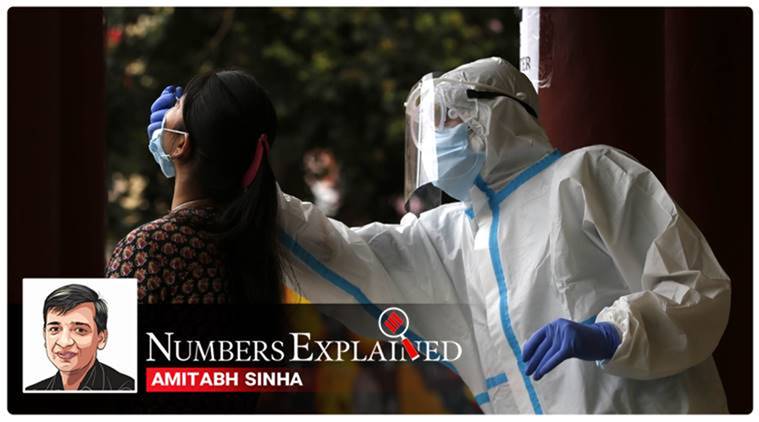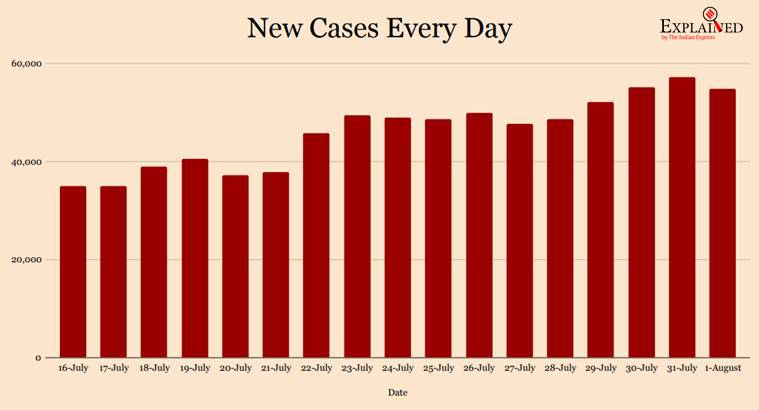
[ad_1]
 A medic waits to collect samples for COVID-19 testing near Red Fort in New Delhi (Express Photo/Amit Mehra)
A medic waits to collect samples for COVID-19 testing near Red Fort in New Delhi (Express Photo/Amit Mehra)
India Coronavirus Cases: The reproduction number, or the number of people getting infected by an already infected person on an average, has fallen below 1 in Delhi, Mumbai and Chennai, for the first time since the novel Coronavirus outbreak began in India in March. When that happens, it usually signals the beginning of the decline of an epidemic in a population group.
The latest projections, made by Sitabhra Sinha and his research group at Institute of Mathematical Sciences in Chennai, thus offer hope, at a time when India is discovering more than 50,000 new cases of infection every day. But there are important caveats. It is only in case of Delhi that this trend (of reproduction number R remaining below 1) has held on for some time, and therefore only in case of Delhi can it be used to make some reliable estimates about a future scenario. In case of Mumbai and Chennai, the present low R-values could just be part of normal variations.

In Delhi’s case, according to the estimates of Sinha’s group, the number of active cases in Delhi could fall below 1,000 by the first week of September. There were about 10,600 active cases in Delhi, as on Friday.
The important thing to remember is that these are estimates for the future based on past data, and not predictions. These estimates are arrived at using certain assumptions about how the situation would evolve. If the actual situation deviates from the assumptions, the results would differ from the estimates. The R-value itself is dependent on the model and assumptions used. Different research groups can arrive at different R-values. These projections, therefore, are important for the trends they point at, and need to be used cautiously for arriving at conclusions.
Having said that, these estimates do not come as a surprise, especially in the case of Delhi, which has had seen a remarkable turnaround in the epidemic situation since the last week of June. On most days in July, there were more people recovering from the disease, than getting infected. Two reasons that could have contributed to the improvement in the situation in Delhi are quite well-known — there was a sharp increasing in testing from the middle of June, and it is claimed that infected people were more effectively identified and isolated, as a result of which they could have infected much lesser number of people.
📣 Express Explained is now on Telegram. Click here to join our channel (@ieexplained) and stay updated with the latest
Top ten states with maximum caseload
| STATE | TOTAL POSITIVE | NEW CASES | TOTAL RECOVERIES | DEATHS
|
| Maharashtra | 431,719 | 9,601 | 266,883 | 15,316 |
| Tamil Nadu | 251,738 | 5,879 | 190,966 | 4,034 |
| Andhra Pradesh | 150,209 | 9,276 | 76,614 | 1,407 |
| Delhi | 136,716 | 1,118 | 122,131 | 3,989 |
| Karnataka | 129,287 | 5,172 | 53,648 | 2,420 |
| Uttar Pradesh | 89,048 | 3,587 | 51,334 | 1,677 |
| West Bengal | 72,777 | 2,589 | 50,517 | 1,629 |
| Telangana | 66,777 | 1,891 | 47,590 | 540 |
| Gujarat | 62,574 | 1,136 | 45,782 | 2,465 |
| Bihar | 54,508 | 3,521 | 35,473 | 312 |
But these two reasons are true for some other states as well. And the results there have not been as remarkable as in the case of Delhi till now. At a smaller scale, however, a similar strategy is said to have worked very well in Dharavi area of Mumbai as well. Dharavi, said to have one of the highest population densities in the world, is now often cited as a successful model in epidemic containment.
While there are all indications that important gains have been achieved in Delhi, the situation in many other states continue to present a very sobering picture. Andhra Pradesh, Karnataka, Kerala, Bihar, West Bengal, Uttar Pradesh, Assam and Odisha are all growing at a fast pace, and pushing India’s overall tally higher and higher every day.
In the projections of Sinha’s team, Andhra Pradesh has the highest R-value, 1.48, in the entire country right now, compared to the current national average of 1.16. It means every group of 100 infected persons in Andhra Pradesh have been passing on the infection to another 148 people on an average. This is consistent with the fact that Andhra Pradesh has been the fastest growing state in the country for more than two weeks now. In July, its total caseload has increased by over nine times.
After three consecutive days of 10,000-plus new cases, Andhra Pradesh reported about 9,200 new infections on Friday. More than 1.5 lakh people have now been infected in the state so far, over half of who are yet to recover from the disease.
Karntaka and Tamil Nadu have been adding more than 5,000 new infections every day, while Uttar Pradesh and Bihar have reached levels of about 3,500 cases every day.
Across the country, more than 54,000 new cases were discovered on Friday, a modest reduction of three continuous days of new highs. There are over 17.5 lakh people in the country who have been infected with the virus at some point, out of which 11.45 lakh, or about 65 per cent, have recovered. More than 37,000 people have so far died.
📣 The Indian Express is now on Telegram. Click here to join our channel (@indianexpress) and stay updated with the latest headlines
For all the latest Explained News, download Indian Express App.
© IE Online Media Services Pvt Ltd
[ad_2]
Source link